Uruguay
Country statistics
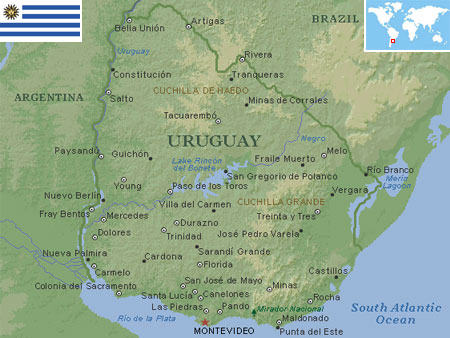
Land area: 67,035 sq miles (173,621 sq km)
Total area: 68,039 sq miles (176,220 sq km)
Population (2010 est.): 3,510,386 (growth rate: 0.4%); birth rate: 13.6/1000; infant mortality rate: 10.9/1000; life expectancy: 76.55; density per sq miles: 51
Capital City: Montevideo
Monetary unit: Uruguay peso
Languages: Spanish, Portunol, or Brazilero
Ethnicity/race: white 88%, mestizo 8%, black 4%
Religions: Roman Catholic 66%, Protestant 2%, Jewish 1%
Country introduction
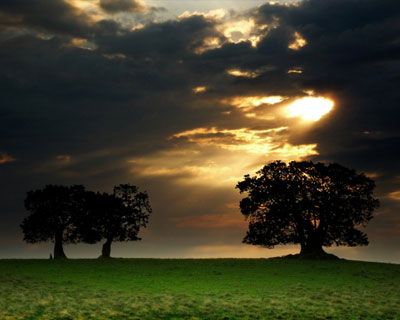
Uruguay is a country in the south-eastern part of South America. It has a South Atlantic Ocean coastline and lies between Argentina to the west and Brazil to the north.
Most of Uruguay is a gently rolling plain that represents a transition from the almost featureless Argentine pampas to the hilly uplands of Southern Brazil. The country itself has flat plains on its eastern, southern, and western edges. The narrow Atlantic coastal plain is sandy and marshy, occasionally broken by shallow lagoons. The littorals of the Río de la Plata and the Río Uruguay are somewhat broader and merge more gradually into the hilly interior.
The remaining three-quarters of the country is a rolling plateau marked by ranges of low hills that become more prominent in the north as they merge into the highlands of Southern Brazil. Even these hilly areas are remarkably featureless and elevations rarely exceed 200 m (656 ft).
Uruguay is a water-rich land. Prominent bodies of water mark its limits on the east, south, and west, and even most of the boundary with Brazil follows small rivers. Lakes and lagoons are numerous, and a high water table makes digging wells easy.
Three systems of rivers drain the land, rivers that flow westward to the Río Uruguay, eastward to the Atlantic or tidal lagoons bordering the ocean, and south to the Río de la Plata. The Río Uruguay, which forms the border with Argentina, is flanked by low banks, and disastrous floods sometimes inundate large areas. The longest and most important of the rivers that drain westward is the Río Negro, which crosses the entire country from the north-east to west before emptying into the Río Uruguay. A dam on the Río Negro at Paso de los Toros has created a reservoir, the Embalse del Río Negro, that is the largest artificial lake in South America. The Río Negro's principal tributary and the country's second most important river is the Río Yí. The rivers flowing east to the Atlantic are generally shallower and have more variable flow than the other rivers. Many empty into lagoons in the coastal plain. The largest coastal lagoon, Laguna Merín, forms part of the border with Brazil. A half-dozen smaller lagoons, some freshwater and some brackish, line the coast farther south.
The culture
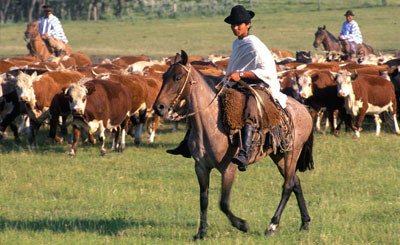
The locals in Uruguay are very friendly and welcoming to visitors. It is customary for Uruguayans to greet people with a kiss on the right cheek and a hug.
Uruguayan culture is an integration of the diverse range of immigrants that inhabited the area. The Spanish and Portuguese influences can be seen in the architecture throughout the main cities and towns and the ancient ruins from the early settlers. The Indigenous Indian rock art can be found at sites throughout the country.
Agriculture is still an important part of the culture and visitors can stay at working ranches and drive live stock with the Gauchos (cowboys). Uruguay's culture is significantly influenced by the gaucho tradition. Cattle ranching has been widespread in the country since colonial times, and its rural roots and traditions remain important to the national identity. Beautifully crafted leather goods have come out of this lifestyle as well. Uruguay is known for its handcrafted leather goods and handmade woollen items, which can be found at art fairs and markets throughout the country.
Music and dance is an integral part of the culture in the form of plays, concerts, exhibitions and festivals. Music was greatly influenced by the immigrants who settled in Uruguay. The folk songs and dances are strongly Argentine in nature except in the north where music seems to have been more influenced by Brazilian strains. The national dance is the Pericon where six or more couples dance together. Other dances are the Cielito, the Media Cana. the Ranchera and the Tango, the latter being the most popular with the locals. The guitar is a popular instrument and is used as an accompaniment instrument. The Europeans brought the polka, waltz, chotis and mazurca into Uruguay, but all of these were given a local touch by the Uruguayans. Uruguay's annual Carnival is a major event with many unique features distinguishing it from those of its neighbours. Rock, jazz, pop, and other Western musical genres also enjoy great popularity in Uruguay.
Though it is a small country Uruguay has a strong literary and artistic tradition. One of Uruguay's most famous works of literature is Ariel by José Enrique Rodó (15 July 1871 - 1 May 1917), which is still widely read today. Modern Uruguayan writers include Juan Carlos Onetti, author of No Man's Land and The Shipyard. One of the most respected of Uruguay artists was the late painter Joaquin Torres Garcia (28 July 1874 - 8 August 1949), a plastic artist and art theorist who was also known as the founder of Constructive Universalism. Punta Ballena is a well-known artist's colony.
Travelers to Uruguay will find that the locals are enthusiastic about football (soccer). The country has won two Olympic gold medals in the sport, as well as the first-ever World Cup. Football games can be seen being played across the country in stadiums, playing fields, yards, and in the street.
Attractions & landmarks
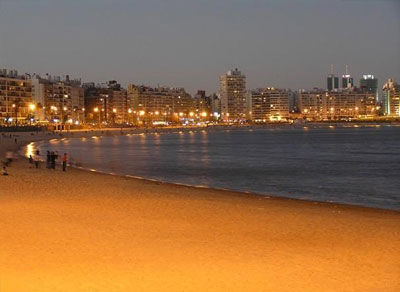
Uruguay is home to numerous scenic shores, fishing and hunting areas, hot springs, horse and cattle ranches, small towns rich in colonial and early national architectural heritage, and an extensive metropolitan area.
Montevideo is the country's capital and is a city bursting with possibilities for visitors. The main attraction here is the La Rambla, a 21 km (13 miles) roadway that runs alongside the city's coastline. It provides a great environment for people to do a variety of activities, such as jogging, walking, biking, fishing, flying kites, or simply chatting, and drinking tea during sunrise or sunset, as the sun touches the water off in the distance. Skateboarding and roller skating are also possible in special designated areas. Further inland, the neighborhood of Pocitos represents modern-day Montevideo with it's high-rise apartments and shopping malls that are replacing older, more ramshackle living quarters. Not far from here is the Plaza de la Constitución, which is widely regarded to be the capital's throbbing heart. Here visitors will find an important cathedral and an artisans' market.
Colonia, also known as Colonia del Sacramento, is Uruguay's other frequently visited city. Life here is vastly different to Montevideo and feels slower, more easygoing, and tranquil. The city is well-preserved with a historic atmosphere and sightseeing involves walking around a lot of the wonderfully evocative old barrios, where community life thrives in narrow, cobbled streets. Winding streets and colorful houses are laid out in a pattern different from Spanish colonial cities, and are a delight to explore. A lighthouse in the heart of the city is open to visitors, where they can climb its stairs, and get a wonderful view from the top.
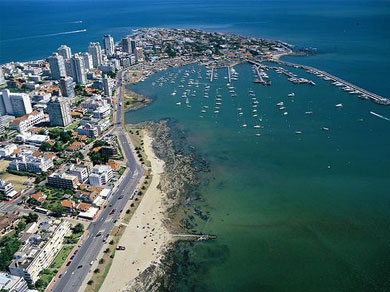
Uruguay's borders has some of the top beaches in South America. The country's east coast borders the South Atlantic Ocean, making for excellent swimming, surfing, and sunbathing opportunities. Fishing is also one of the main tourist attractions in Uruguay. Big-game fishing in the sea is possible for tourists visiting the coastal areas, while many sleepy fishing villages next to the river inland make for fascinating overnight stays where visitors can try to catch tasty fresh water fish.
One large fishing port, Punta del Este, has become a particularly popular place for vacation-goers over the years. The beach resort town has casinos, beaches, yachts, bars and clubs. Many tourists come from the other side of the Rio de la Plata from Argentina to get some nice fun in the sun on a beach, away from the brown waters of the Rio de la Plata.